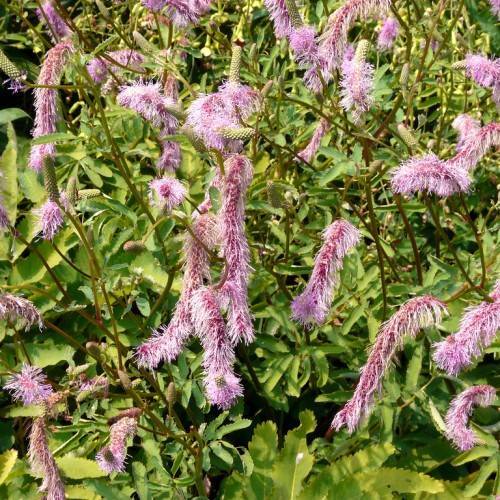
bottlebrush
Sanguisorba obtusa
Cycle:
Herbaceous Perennial
Watering:
Average
Hardiness Zone:
4
Flowers:
Flowers In Summer
Sun:
full sun
Soil:
Well-drained
Fruits:
Fruits In Autumn Ready In
Leaf:
Yes
Growth Rate:
High
Maintenance:
Moderate
Drought Tolerant:
Yes
Salt Tolerant:
Yes
Care Level:
Medium
watering
Bottlebrush plants should be watered regularly, with approximately 1 to 2 inches of water each week. Soak the soil thoroughly, but avoid overwatering. In the summertime, however, if the temperature is hot and the growing conditions are dry, you may need to water more often. In that case, provide about 1 inch of water every 5 to 7 days during the warmer months. To help maintain soil moisture and keep weeds in check, mulch your bottlebrush plant with 2 to 3 inches of natural material such as bark, wood chips or pine needles.
sunlight
Bottlebrush (Sanguisorba obtusa) does best in full sun, meaning that it should receive at least 6-8 hours of direct sunlight every day. This plant species prefers to be in a sunnier spot (especially during the late spring, summer, and early fall months) and become leggy if planted too far from a light source. It is best to provide bottlebrush with sunlight throughout much of the day during the spring and summer growing months, while partial shade is still preferred in the winter months. It is also important to note that bottlebrush should be sheltered from strong winds, as they can cause damage to the delicate leaves.
pruning
Bottlebrush plants should be pruned after they have finished blooming. If you wait too long to prune, the spent flowers will become woody and difficult to remove. Generally the best time to prune is late spring or early summer (May-July). When pruning, remove large branches, dead wood, and any weak or broken branches. This will encourage the bottlebrush to produce healthier, more bushy growth. It’s also important to thin out the center stems and remove any crossing branches to allow for better air circulation and light penetration. Generally, you should aim to remove no more than a third of the overall growth.
